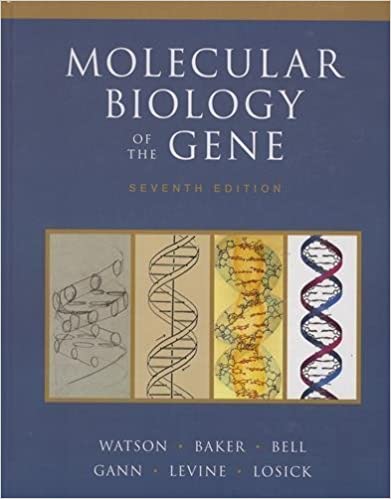
Molecular Biology of the Gene 7th Edition by Richard Losick, James Watson, Michael Levine, Tamara Baker, Alexander Gann
Edition 7ISBN: 9780321762436
Molecular Biology of the Gene 7th Edition by Richard Losick, James Watson, Michael Levine, Tamara Baker, Alexander Gann
Edition 7ISBN: 9780321762436 Exercise 10
A translation initiation factor, called Tif3 or eIRF4B, in yeast cells has the following sequence of elements in its polypeptide chain: an amino-terminal domain containing an RNA recognition motif (RRM), a Central segment with a seven-fold repeated sequence rich in basic and acidic amino acid residues, and a carboxy-terminal region with no evident homology to known motifs or domains.
A. Describe the significance of RRMs.
The modularity of the protein suggested the following series of experiments, to analyze the roles of its different parts. Cells with a deletion of the TIF 3 gene do not grow at 37°C?but grow normally at 30°C. By adding a gene that encodes a fragment of the protein, it is possible to assay for complementation-the capacity of that fragment to confer wild-type growth at 37°C. The results of such experiments are shown in the table below, in which ++?+?and ? indicate the degree of growth/complementation.

B. From these data, which region of the protein is required for wild-type growth at 37°C?
A further set of experiments involved an in vitro translation assay, using an extract from the strain lacking the TIF3 gene. The reaction was initiated by adding purified Tif3 protein or one of its truncated forms. The results are in the table below, which shows the percentage of in vitro translation relative to the reaction with full-length Tif3.

C. How do these results compare with the complementation results in part B? Do they modify your conclusion from the genetic experiments?
Data adapted from Niederberger et al. (1998. RNA 4: 1259-1267).
A. Describe the significance of RRMs.
The modularity of the protein suggested the following series of experiments, to analyze the roles of its different parts. Cells with a deletion of the TIF 3 gene do not grow at 37°C?but grow normally at 30°C. By adding a gene that encodes a fragment of the protein, it is possible to assay for complementation-the capacity of that fragment to confer wild-type growth at 37°C. The results of such experiments are shown in the table below, in which ++?+?and ? indicate the degree of growth/complementation.

B. From these data, which region of the protein is required for wild-type growth at 37°C?
A further set of experiments involved an in vitro translation assay, using an extract from the strain lacking the TIF3 gene. The reaction was initiated by adding purified Tif3 protein or one of its truncated forms. The results are in the table below, which shows the percentage of in vitro translation relative to the reaction with full-length Tif3.

C. How do these results compare with the complementation results in part B? Do they modify your conclusion from the genetic experiments?
Data adapted from Niederberger et al. (1998. RNA 4: 1259-1267).
Explanation
The translation initiation factor Tif3 o...
Molecular Biology of the Gene 7th Edition by Richard Losick, James Watson, Michael Levine, Tamara Baker, Alexander Gann
Why don’t you like this exercise?
Other Minimum 8 character and maximum 255 character
Character 255


